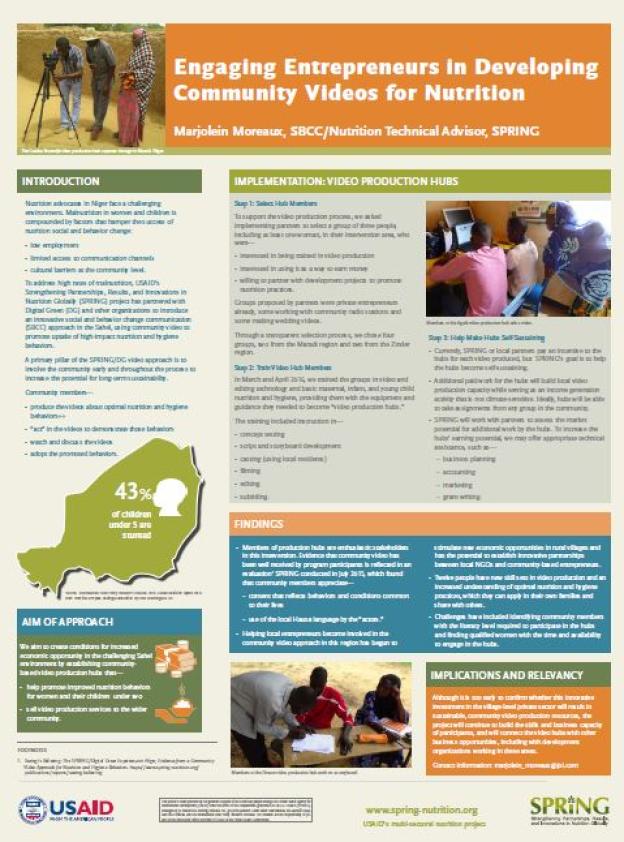Introduction
Nutrition advocates in Niger face a challenging environment. Malnutrition in women and children is compounded by factors that hamper the success of nutrition social and behavior change:
- low employment
- limited access to communication channels
- cultural barriers at the community level.
To address high rates of malnutrition, SPRING has partnered with Digital Green (DG) and other organizations to introduce an innovative social and behavior change communication (SBCC) approach in the Sahel, using community video to promote uptake of high-impact nutrition and hygiene behaviors.
A primary pillar of the SPRING/DG video approach is to involve the community early and throughout the process to increase the potential for long-term sustainability.
Community members—
- produce the videos about optimal nutrition and hygiene behaviors
- “act” in the videos to demonstrate those behaviors
- watch and discuss the videos
- adopt the promoted behaviors.
Aim of Approach
We aim to create conditions for increased economic opportunity in the challenging Sahel environment by establishing communitybased video production hubs that—
- help promote improved nutrition behaviors for women and their children under two
- sell video production services to the wider community.
Implementation: Video Production Hubs
Step 1: Select Hub Members
To support the video production process, we asked implementing partners to select a group of three people, including at least one woman, in their intervention area, who were—
- interested in being trained in video production
- interested in using it as a way to earn money
- willing to partner with development projects to promote nutrition practices.
Groups proposed by partners were private entrepreneurs already, some working with community radio stations and some making wedding videos.
Through a transparent selection process, we chose four groups, two from the Maradi region and two from the Zinder region.
Step 2: Train Video Hub Members
In March and April 2016, we trained the groups in video and editing technology and basic maternal, infant, and young child nutrition and hygiene, providing them with the equipment and guidance they needed to become “video production hubs.”
The training included instruction in—
- concept testing
- script and storyboard development
- casting (using local residents)
- filming
- editing
- subtitling.
Step 3: Help Make Hubs Self-Sustaining
- Currently, SPRING or local partners pay an incentive to the hubs for each video produced, but SPRING’s goal is to help the hubs become self-sustaining.
- Additional paid work for the hubs will build local video production capacity while serving as an income generation activity that is not climate-sensitive. Ideally, hubs will be able to take assignments from any group in the community.
- SPRING will work with partners to assess the market potential for additional work by the hubs. To increase the hubs’ earning potential, we may offer appropriate technical assistance, such as—
- business planning
- accounting
- marketing
- grant writing.
Findings
- Members of production hubs are enthusiastic stakeholders in this intervention. Evidence that community video has been well received by program participants is reflected in an evaluation SPRING conducted in July 2015, which found that community members appreciate—
- content that reflects behaviors and conditions common to their lives
- use of the local Hausa language by the “actors.”
- Helping local entrepreneurs become involved in the community video approach in this region has begun to stimulate new economic opportunities in rural villages and has the potential to establish innovative partnerships between local NGOs and community-based entrepreneurs.
- Twelve people have new skill sets in video production and an increased understanding of optimal nutrition and hygiene practices, which they can apply in their own families and share with others.
- Challenges have included identifying community members with the literacy level required to participate in the hubs and finding qualified women with the time and availability to engage in the hubs.
Implications and Relevancy
Although it is too early to confirm whether this innovative investment in the village-level private sector will result in sustainable, community video production resources, the project will continue to build the skills and business capacity of participants, and will connect the video hubs with other business opportunities, including with development organizations working in these areas.
